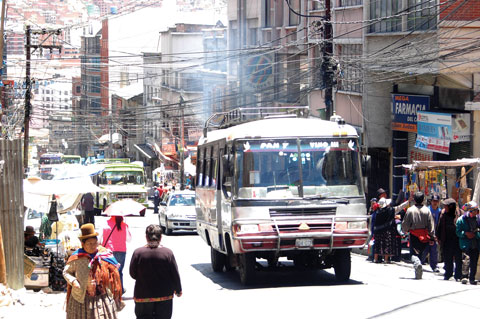Jim visited Bolivia last month. He snapped the beautifully adorned buses for the Bus and Coach Association’s Circular magazine, but avoided travelling on them.

Bolivia’s bus drivers chew coca leaves to stay alert, and some believe that beer also enhances their state of alertness. But the reality is that the combination of copious amounts of beer and coca has more than once resulted in multiple fatalities, when a driver has misjudged a turn and plunged thousands of metres off the road.
In what may have been Bolivia’s worst bus disaster, in 1983, a drunk bus driver veered off the road just out of the capital, La Paz, killing 100 passengers. But it was far from the only accident on that particular highway, known as El Camino de la Muerte (the Death Highway) or the Yungas Road, which plunges from 4650 metres altitude near La Paz to 1200 metres at the town of Coroico, 60 kilometres away. It’s been estimated that around 300 people died annually on this single stretch of road, before it was replaced in 2006 by a ‘safer’ highway.
Ironically, the famed danger of the old road means it is now a popular tourist destination, with mountain biking enthusiasts. Nevertheless, it remains dangerous and at least 18 cyclists have been killed on the route since 1998.
Last month, I travelled on similar roads. As we approached the central Bolivian town of Caranave, I was in the back of a landrover driven by Lisa, the German aid worker who was showing us around the coffee growing regions of Bolivia. It was getting dark, but the yelps, sighs and screams from my fellow passengers in the front were a sure sign that we were in some precipitous terrain. We were making our way down a rutted single lane unsealed road with a drop of hundreds of metres to the valley floor below.
Lisa slowed the vehicle as we passed some candles by the side of the road, surrounded with flowers. She nonchalantly informed us that a bus had gone into the ravine just a week ago. Officially, there were only 48 people on board, but the bus was packed with Bolivians heading to a festival in Caranave and the driver was apparently speeding so as to arrive in time for the festivities. Miraculously, only eight of the passengers on board were killed by the 200-metre fall. Almost as an afterthought, Lisa told us about another bus that had also crashed off a cliff on the same stretch of road in the same week: 13 had been killed.
In late July, 25 people had been killed in yet another bus accident further south. It began to feel strangely normal. Readers will, I hope, excuse me when I say that I was glad I was not travelling through Bolivia by bus. They look great, but I just wasn’t ready to make the commitment needed to travel in them.
But while the roads are from another time zone, the buses themselves are beautiful and the most commonly used form of transport in the country. Within towns and cities, “micros”, which are supposed to carry only 24 passengers at a time but rarely do, hurtle down narrow streets, often racing each other and making terrifying lane changes with no regard for their passengers’ safety. They stream down the main streets, usually with a teenager or child (who is probably the son or daughter of the driver) screaming out the eventual destination.
“Colectivos” are the standard low budget bus option, mainly old Dodge US school buses from the 1960s and 1970s and lacking comforts such as air conditioning or reclining seats. They are also often packed high with cargo – some have been known to topple over from the weight. Their 318 cubic inch gas V8 engines spew copious amounts of fumes – add that to the high altitude (La Paz is 3400 metres above sea level) and breathing near the buses can be laboured.
It all adds to the otherworldly feel of this thin aired city, and this extraordinary country.